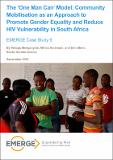| dc.contributor.author | Mokganyetji, Tebogo | |
| dc.contributor.author | Anderson, Althea | |
| dc.contributor.author | Stern, Erin | |
| dc.coverage.spatial | South Africa | en |
| dc.date.accessioned | 2015-10-05T12:29:52Z | |
| dc.date.available | 2015-10-05T12:29:52Z | |
| dc.date.issued | 2015-10-05 | |
| dc.identifier.citation | Mokganyetji, T., Anderson, A., and Stern, E. (2015) The ‘One Man Can’ Model: Community Mobilisation as an Approach to Promote Gender Equality and Reduce HIV Vulnerability in South Africa, EMERGE Case Study 6, Promundo-US, Sonke Gender Justice and the Institute of Development Studies | en |
| dc.identifier.isbn | 978 1 78118 272 7 | |
| dc.identifier.uri | https://opendocs.ids.ac.uk/opendocs/handle/20.500.12413/7086 | |
| dc.description.abstract | One of the main contextual factors driving the HIV epidemic in Sub-Saharan Africa is shared social norms reinforcing restrictive masculine and feminine roles and inequitable gender relationships, which limit women’s ability to protect themselves from HIV while simultaneously putting social pressure on men to take on a range of sexual and health risks. A growing body of scholarship and programme development focuses on the impacts of engaging men and boys in reducing women’s and girls’ HIV vulnerability as well as improving men’s health and well being. To further understand the benefits of engaging men and boys for gender equality and HIV prevention, this study explores the impacts of the South African non government organisation, Sonke Gender Justice’s ‘One Man Can’ (OMC) community mobilisation approach in a multi level HIV prevention intervention to address the community level factors that contribute to women and girls’ increased HIV vulnerability and men’s HIV risk taking behaviour.
This case study examines qualitative data collected as part of a gender equality and HIV prevention intervention implemented in rural South Africa that engaged men 18 to 35 years old to increase their support for girls’ and women’s rights and to decrease men’s unsafe sexual practices, especially those that increase girls’ and young women’s vulnerability to HIV infection. Our findings indicate significant attitudinal and some behavioural changes around gender and HIV risk amongst OMC community mobilisers, community action team (CAT) members, and community members exposed to the intervention. At the interpersonal level, adoption of gender equitable beliefs and values had positive effects of improved interpersonal communication and a more balanced division of labour in the home. At the community level, participation in collective activities and increased social awareness of men’s and women’s unique HIV vulnerabilities produced changes in community members’ lives and relationships and created new pathways for collective action for social change. Key lessons learned and potential policy implications are offered. | en |
| dc.language.iso | en | en |
| dc.publisher | Promundo-US, Sonke Gender Justice and the Institute of Development Studies | en |
| dc.relation.ispartofseries | EMERGE Case Study;6 | |
| dc.rights | You are free to:
Share — copy and redistribute the material in any medium or format
Adapt — remix, transform, and build upon the material
For any purpose, even commercially. The licensor cannot revoke these freedoms as long as you follow these license terms.
License terms: You must give appropriate credit, provide a link to the license, and indicate if changes were made. You may do so in any reasonable manner, but not in any way that suggests the licensor endorses you or your use. | en |
| dc.rights.uri | http://www.ids.ac.uk/files/dmfile/IDSOpenDocsStandardTermsOfUse.pdf | en |
| dc.subject | Sexuality and Development | en |
| dc.title | The ‘One Man Can’ Model: Community Mobilisation as an Approach to Promote Gender Equality and Reduce HIV Vulnerability in South Africa | en |
| dc.type | Series paper (non-IDS) | en |
| dc.rights.holder | Institute of Development Studies, Promundo-US and Sonke Gender Justice | en |
| dc.identifier.team | Gender and Sexuality | en |

